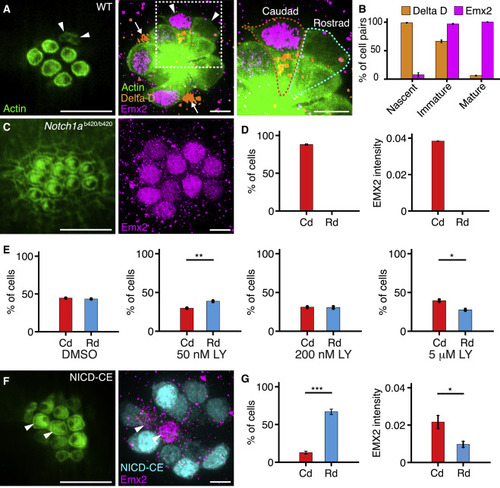
Experimental Perturbations of the Notch Signaling Pathway (A) An apical view of a 4 dpf wild-type neuromast (left) reveals three mature pairs of hair cells and one immature pair (arrowheads). A view at the nuclear level (center) shows immunolabeling of the same neuromast for Emx2 (magenta) and Delta D (orange). An enlargement of the boxed area (right) includes outlines of the two immature hair cells. Hair-cell progenitors also express Delta D (arrows). (B) Delta D is expressed in at least one hair cell of each pair at earlier stages of development than Emx2 (51 nascent pairs, 101 immature pairs, 259 mature pairs). (C) In a Notch1ab420/b420 mutant, hair cells show a caudad polarization (left) and uniformly express Emx2 (right). (D) These effects are consistent in 536 hair cells from 57 neuromasts. (E) The γ-secretase inhibitor LY411575 creates a polarity bias that lies in the rostrad direction for low concentrations but becomes caudad at higher concentrations. The measurements were made as follows: for 50 nM compound, 160 caudad and 205 rostrad hair cells in 37 neuromasts; for 200 nM compound, 47 caudad and 48 rostrad hair cells in 12 neuromasts; and for 5 μM compound, 164 caudad and 114 rostrad hair cells in 19 neuromasts. (F) In an NICD-CE transgenic animal, most hair cells are polarized in the rostrad direction (left). Occasional hair cells (arrowheads) fail to express NICD-CE; they instead contain Emx2 (magenta, right) and adopt a caudad sensitivity. (G) The effect is quantified for 68 cells from 21 neuromasts. Scale bars, 5 μm. Means ± SEM; ∗∗∗p < 0.001; ∗∗p < 0.01; ∗p < 0.05. See also Figure S3 and Videos S1, S2, S3, and S4.
|

